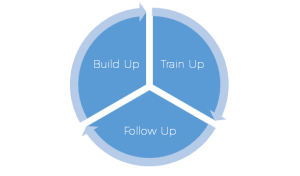
Recently, I have been engaged with a client on a campaign. A campaign to affect specific business metrics. As we become fully involved in the process, two things have come into view. One, culture. Is the culture in the right place to support this goal? I know the definition of company culture can be broad (see my post if we are asking the right question about culture). Has it been clearly defined?
For the sake of context, culture represents the company’s “vibe”. It’s the expectations and perceptions of the brand. What it stands for and how it does what it does with every customer that shows up. It can be as amorphous (without shape or form) as things like fun, honesty and integrity. Great ideals and subject to someone’s relative understanding of what that can look like or sound like. It can also be incredibly structured like “Greet all customers within 30 seconds”. While I appreciate the concrete expectation, what if they do it in 32 seconds? Do you write them up? Technically, they are non-compliant. I save that one for later. Consider culture for now to be those things that make up expected team member behavior.
Two, if culture is important to any campaign or initiative, then it is only as successful as the team member’s ability to create and execute that culture experience. This unified relationship of a culture clarity and the team member’s understanding becomes a hinge. A hinge that depends on the team member’s ability to link the company’s brand and value proposition with the customer’s need and desire for satisfaction with the “widget”.
Let’s be real, the question is how do we get Skippy, Todd and Mary to “do” this campaign every day with every customer?
I will follow a simple format and tag each element in order. Build Up is, for lack of a better word, orientation. It is the process that must establish the “what, why, how and to what extent” behind the company, its culture and its objectives.
If a company want to raise their closing ratio by 10 percent, it had better clearly lay out what that means…the part it plays in the business, with the customer and to the team.
It must provide a why or the goal’s reason for being. This would include the ubiquitous WIIFM and all additional benefits to additional parties. Think greater good and not just because we said so.
It needs to have the behavior, ways and means to achieve this goal. How many of you have been told to do something, but not given the how to do it? This can be specific examples, stories for context and what good looks like.
And it must have a target, a scorecard or some type of way to know we are there. To say the goal is 10 percent and then not show currently where we are, what we have done and how we are doing on the way to get there…well, why does anyone keep score?
Can the answers to these questions build up the momentum to achieve a company’s goal? Not alone. It must have the other elements in play. Elements involving training and following up. For now, it is about establishing purpose and meaning.
In a recent survey by UNC Kenan-Flagler Business School in partnership with the Young Entrepreneurs Council found that millennials prioritized “meaningful work” over high pay. Couple this with 70% of millennials are planning to change jobs once the economy improves. And 65% of millennials said personal development was the most influential factor in their current job.
What if you as manager and leader consider those three things today and how they factor in your business…in your culture? What would your next steps and action plan look like?
If your goal is to increase whatever by 10 percent, where do you start?
Look at your culture and then look at the rep who provides it. Have you given them meaning…individually and collectively?
Tomorrow, Training Up.
